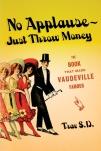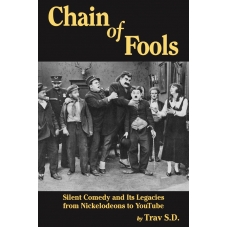Today is the birthday of J. Stuart Blackton (1875-1941), an important figure in American show biz history on several fronts who deserves to be much better known. Born in Yorkshire, England he moved with his family to New York at age 10, and went into vaudeville in 1894 in a most unusual act with Albert E. Smith and Ronald A. Reader. Reader operated a magic lantern, Smith was a “Komical Konjurer” and Blackton a “Komical Kartoonist”. Essentially, he was a lightning sketch artist (a common performance category at the time), someone who drew (and altered) pictures really fast while they delivered a rapid line of patter.
After the act failed to get any traction, the team broke up, and Blackton got a job as an illustrator and reporter for the New York Evening World (newspapers were not yet printing photographs; they relied heavily on drawings). In 1896, he got an assignment to interview Thomas Edison and learn about his new Vitascope, an early motion picture projector. The upshot is that Blackton and Smith ended up buying a projector and camera and nine films from Edison, including one that Blackton had made of himself drawing a lightning sketch of the inventor. They went back into show business exhibiting films, and became Vitagraph Studios. (The name an obvious riff on, if not rip-off of, Biograph). Silent comedy fans know Vitagraph well: the studio released the comedies of John Bunny and Flora Finch, and others; their biggest star of the late teens and early twenties was Larry Semon, often supported by Oliver Hardy, Stan Laurel, Frank Alexander and others. He also did six live action adaptions of the comic strip Happy Hooligan (starring himself) and those famous faked newsreel shots of naval battles during the Spanish-American war.
But Blackton should be well known for another reason. Between 1900 and 1907, he made many films experimenting with stop motion techniques that were groundbreaking in the development of modern animation (he is considered one of its fathers). By 1909, he was no longer directing, just devoting all of his time to being studio chief. In 1915, Vitagraph, in partnership with Lubin, Selig, and Essanay formed a distribution cooperative known as V-L-S-E, organized by George Kleine, founder of Kalem. Only Vitagraph’s brand long survived the arrangement.
Blackton remained until the studio was sold to Warner Brothers in 1925 (with one five year hiatus 1917-1923 when he worked as an independent producer). Warner Brothers took over Vitagraph’s Flatbush Brooklyn facility and wired it for sound. You know it as…Vitaphone.
Here’s one of Blackton’s seminal films from 1906, “Humorous Phases of Funny Faces”, now in the collection of the Library of Congress:
For more on silent and slapstick comedy don’t miss my new book Chain of Fools: Silent Comedy and Its Legacies from Nickelodeons to Youtube, just released by Bear Manor Media, also available from amazon.com etc etc etc
To find out more about the variety arts past and present, consult No Applause, Just Throw Money: The Book That Made Vaudeville Famous, available at Amazon, Barnes and Noble, and wherever nutty books are sold.


![220px-JStuartBlackton1912[1]](https://travsd.files.wordpress.com/2013/01/220px-jstuartblackton19121.jpg?w=204&h=300)

[…] WordPress – https://travsd.wordpress.com/2013/01/05/stars-of-slapstick-49-j-stuart-blackton/ […]
LikeLike